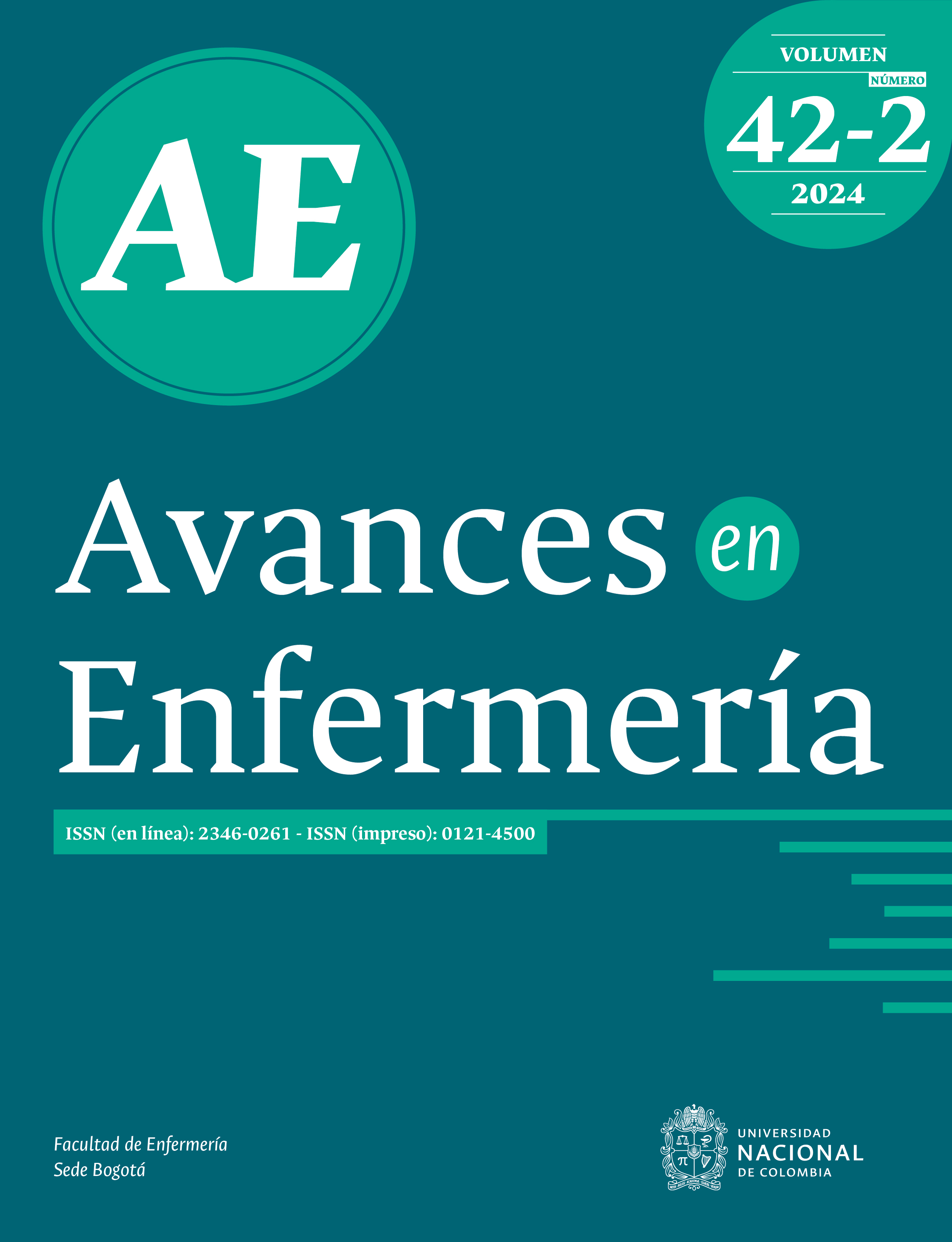Demystifying aggression in response to smoking bans in psychiatry
Desmitificación de la agresividad ante la prohibición del tabaco en psiquiatría
Desmistificação da agressividade diante da proibição do fumo em psiquiatria
DOI:
https://doi.org/10.15446/av.enferm.v42n2.114168Keywords:
Hospitals, Psychiatric, Psychiatric Nursing, Smoke-free Environments, Smoke-free Policy, Tobacco Use Disorder (en)Hospitales Psiquiátricos, Enfermería Psiquiátrica, Ambientes Libres de Humo, Política para Fumadores, Tabaquismo (es)
Hospitais Psiquiátricos, Enfermagem Psiquiátrica, Ambientes Livres de Fumo, Política Antifumo, Tabagismo (pt)
Downloads
Objective: To investigate the aggressive behaviors of patients in a psychiatric hospital adhering to the anti-smoking law and to identify their associated factors.
Materials and method: This cross-sectional epidemiological study analyzed the medical records of 573 discharged patients from a Brazilian psychiatric hospital. The response variables included verbal aggression, physical aggression, physical restraint, and mechanical restraint. Multiple Poisson regression models were applied for analysis.
Results: Approximately 48% of the patients were smokers. Aggression was found to be 121% higher among younger patients (aged 19-35), 73% higher among those with longer hospital stays, 55% higher among individuals hospitalized involuntarily, and 89% higher among those prescribed five or more psychotropic drugs, independent of other variables. Additionally, individuals hospitalized after the implementation of the smoking ban exhibited 55% fewer aggressive behaviors compared to those hospitalized prior to the ban.
Conclusions: The study revealed that the associations between smoking and aggression, as well as the duration of hospitalization relative to the smoking ban, were influenced by personal and clinical variables. Cultural beliefs about the perceived benefits of smoking may be perpetuated among individuals with mental disorders, while older nursing professionals might influence younger colleagues’
perspectives on permitting smoking in mental health settings as a means of mitigating aggression. Breaking this cycle of misinformation requires generating new knowledge and insights, which represents a significant contribution of this study.
Objetivo: investigar los comportamientos agresivos de los pacientes en un hospital psiquiátrico que cumple con la ley antitabaco e identificar los factores asociados a dichos comportamientos.
Materiales y método: el presente estudio epidemiológico transversal analizó las historias clínicas de 573 pacientes dados de alta de un hospital psiquiátrico en Brasil. Las variables de respuesta incluyeron comportamientos agresivos verbales, comportamientos agresivos físicos, restricción física y restricción mecánica. Para el análisis, se desarrollaron modelos de regresión de Poisson múltiple.
Resultados: cerca del 48 % de los pacientes eran fumadores. Independientemente de otras variables, la agresión fue 121 % mayor entre los jóvenes (19-35 años), 73 % mayor entre aquellos con estancias hospitalarias prolongadas, 55 % mayor entre individuos hospitalizados involuntariamente y 89 % mayor entre aquellos que usaban cinco o más medicamentos psicotrópicos. Además, los individuos hospitalizados después de la prohibición de fumar presentaron una incidencia 55 % menor de comportamientos agresivos en comparación con aquellos hospitalizados antes de esta prohibición.
Conclusiones: las asociaciones entre el tabaquismo y la agresión, así como la duración de la hospitalización en relación con la prohibición de fumar, estuvieron influenciadas por variables personales y clínicas. Las creencias culturales sobre los beneficios del tabaquismo pueden transmitirse entre individuos con trastornos
mentales, mientras que los profesionales de enfermería de mayor edad podrían influir en las opiniones de los colegas más jóvenes sobre la permisibilidad de fumar en entornos de salud mental como una forma de mitigar la agresión. Romper este ciclo de desinformación requiere generar nuevos conocimientos y perspectivas, lo que constituye una contribución clave de este estudio.
Objetivo: investigar os comportamentos agressivos de pacientes de um hospital psiquiátrico adepto à lei antifumo e identificar os fatores associados.
Materiais e método: este estudo epidemiológico transversal analisa os prontuários médicos de 573 pacientes egressos de um hospital psiquiátrico brasileiro. As variáveis de resposta incluíram comportamentos agressivos verbais, comportamento agressivo físico, contenção física e contenção mecânica. Foram desenvolvidos modelos de regressão de Poisson múltipla.
Resultados: aproximadamente 48% dos pacientes eram fumantes. Independentemente das outras variáveis, a agressão foi 121% maior entre os jovens (19-35 anos), 73% maior entre as pessoas que ficaram mais tempo no hospital, 55% maior entre aqueles hospitalizados involuntariamente e 89% maior entre aqueles que usavam
cinco ou mais psicotrópicos. As pessoas hospitalizadas após a proibição de fumar mostraram 55% menos comportamentos agressivos do que aquelas hospitalizadas
antes da proibição.
Conclusões: as associações entre tabagismo e agressão, assim como a duração da hospitalização com relação à proibição de fumar, foram influenciadas por variáveis
pessoais e clínicas. Crenças culturais sobre os benefícios do tabagismo podem ser transmitidas entre indivíduos com transtornos mentais, enquanto os profissionais de enfermagem de mais idade poderiam influenciar as opiniões dos colegas mais jovens sobre a permissibilidade de fumar em ambientes de saúde mental para mitigar a agressão. Quebrar esse ciclo de desinformação requer gerar conhecimentos e perspectivas, o que representa uma contribuição-chave deste estudo.
References
(1) Daugherty B; Warburton K; Stahl SM. A social history of serious mental illness. CNS Spectr. 2020;25(5):584-592. https://doi.org/10.1017/s1092852920001364
(2) Houston R. Past and “pastism” in the history of psychiatry. Lancet Psychiatry. 2019;6(3):206-208. https://doi.org/10.1016/s2215-0366(19)30055-0
(3) Mental Health Ireland. Findings from The National Conversation Café on Smoking, Mental Health and Recovery. Dublin: Mental Health Ireland; 2020. https://www.mentalhealthireland.ie/wp-content/uploads/2020/03/Smoking-Mental-Health-Recovery-Conversation-Cafe-Findings-Report.pdf
(4) Smith CA; McNeill A; Kock L; Shahab L. Exploring mental health professionals’ practice in relation to smoke-free policy within a mental health trust: A qualitative study using the COM-B model of behaviour. BMC Psychiatry. 2019;19(54):1-12. https://doi.org/10.1186/s12888-019-2029-3
(5) Coustals N; Martelli C; Brunet-Lecomte M; Petillion A; Romeo B; Benyamina A. Chronic smoking and cognition in patients with schizophrenia: A meta-analysis. Schizophr Res. 2020;222:113-121. https://doi.org/10.1016/j.schres.2020.03.071
(6) Cunningham R; Poppe K; Peterson D; Every-Palmer S; Soosay I; Jackson R. Prediction of cardiovascular disease risk among people with severe mental illness: A cohort study. PLoS One. 2019;14(9):e0221521. https://doi.org/10.1371/journal.pone.0221521
(7) Ding JB; Hu K. Cigarette smoking and schizophrenia: Etiology, clinical, pharmacological, and treatment implications. Schizophr. res. treat. 2021;2021(1):7698030. https://doi.org/10.1155/2021/7698030
(8) Orri M; Séguin JR; Castellanos-Ryan N; Tremblay RE; Côté SM; Turecki G et al. A genetically informed study on the association of cannabis, alcohol, and tobacco smoking with suicide attempt. Mol Psychiatry. 2021;26(9):5061-5070. https://doi.org/10.1038/s41380-020-0785-6
(9) Asharani PV; Ling Seet VA; Abdin E; Siva Kumar FD; Wang P; Roystonn K et al. Smoking and mental illness: Prevalence, patterns and correlates of smoking and smoking cessation among psychiatric patients. Int. j. environ. res. public health. 2020;17(15):5571. https://doi.org/10.3390/ijerph17155571
(10) Lin SC; Gathua N; Thompson C; Sripipatana A; Makaroff L. Disparities in smoking prevalence and associations with mental health and substance use disorders in underserved communities across the United States. Cancer. 2022;128(9):1826-1831. https://doi.org/10.1002/cncr.34132
(11) Giles L; Bauer L; Batchelor S. Assessing the responses of smokers to requests to stop smoking on hospital grounds. Health Promot. J. Austr. 2022;33(2):435-444. https://doi.org/10.1002/hpja.513
(12) Hedges E; Facer-Irwin E. Implementation of a smoke-free policy appears to reduce physical violence in inpatient settings. BMJ Mental Health. 2019;22(2):e8. https://doi.org/10.1136/ebmental-2018-300072
(13) Spaducci G; McNeill A; Hubbard K; Stewart D; Yates M; Robson D. Smoking-related violence in a mental health setting following the implementation of a comprehensive smoke-free policy: A content analysis of incident reports. Int. J. Ment. Health Nurs. 2020;29(2):202-211. https://doi.org/10.1111/inm.12659
(14) Weltens I; Bak M; Verhagen S; Vandenberk E; Domen P; van Amelsvoort T et al. Aggression on the psychiatric ward: Prevalence and risk factors. A systematic review of the literature. PLoS One. 2021;16(10):0258346. https://doi.org/10.1371/journal.pone.0258346
(15) Van den Berg C; van Berkel CJM; van der Meer PB; Tijsterman BWA; van Balkom AWM; Scheepers FE et al. Effects of a smoke-free policy on healthcare staff attitudes and aggression in psychiatry. Tijdschr Psychiatr. 2024;66(2):70-75. https://www.tijdschriftvoorpsychiatrie.nl/en/artikelen/article/50-13283_Effecten-van-een-rookvrijbeleid-opattitudes-zorgpersoneel-en-agressie-in-de-psychiatrie
(16) Oliveira RM; Santos JLF; Furegato ARF. Nurses’ beliefs, attitudes, and opinions regarding a smoking ban in a psychiatric hospital. Nursing. 2022;52(4):55-61. https://doi.org/10.1097/01.nurse.0000823292.67439.12
(17) Spaducci G; Stubbs B; McNeill A; Stewart D; Robson D. Violence in mental health settings: A systematic review. Int J Ment Health Nurs. 2018;27(1):33-45. https://doi.org/10.1111/inm.12425
(18) Chawłowska E; Karasiewicz M; Marcinkowska K; Giernaś B; Jóźwiak P; Lipiak A. Nurses’ perspectives on smoking policies, safety and cessation support in psychiatric wards: A cross-sectional survey. Healthcare. 2022;10(9):1735. https://doi.org/10.3390/healthcare10091735
(19) Hair JF. Multivariate data analysis. London: Pearson; 2009.
(20) O’Brien RM. A caution regarding rules of thumb for variance inflation factors. Qual Quant. 2007;41:673-690. https://doi.org/10.1007/s11135-006-9018-6
(21) Ghossoub E; Cherro M; Akil C; Gharzeddine Y. Mental illness and the risk of self- and other-directed aggression: Results from the National Survey on Drug Use and Health. J. Psychiatr. Res. 2021;132:161-166. https://doi.org/10.1016/j.jpsychires.2020.10.010
(22) Cole C; Vandamme A; Bermpohl F; Czernin K; Wullschleger A; Mahler L. Correlates of seclusion and restraint of patients admitted to psychiatric inpatient treatment via a German emergency room. J. Psychiatr. Res. 2020;130:201-206. https://doi.org/10.1016/j.jpsychires.2020.07.033
(23) Chieze M; Kaiser S; Courvoisier D; Hurst S; Sentissi O; Fredouille J et al. Prevalence and risk factors for seclusion and restraint in old-age psychiatry inpatient units. BMC Psychiatry. 2021;21(82):1-10. https://doi.org/10.1186/s12888-021-03095-4
(24) Lee TK; Välimäki M; Lantta T. The knowledge, practice and attitudes of nurses regarding physical restraint: Survey results from psychiatric inpatient settings. Int. j. environ. res. public health. 2021;18(13):6747. https://doi.org/10.3390/ijerph18136747
(25) Schlup N; Gehri B; Simon M. Prevalence and severity of verbal, physical, and sexual inpatient violence against nurses in Swiss psychiatric hospitals and associated nurse-related characteristics: Cross-sectional multicentre study. Int J Ment Health Nurs. 2021;30(6):1550-1563. https://doi.org/10.1111/inm.12905
(26) Malone V; Harrison R; Daker-White G. Mental health service user and staff perspectives on tobacco addiction and smoking cessation: A meta-synthesis of published qualitative studies. J. Psychiatr. Ment. Health Nurs. 2018;25(4):270-282. https://doi.org/10.1111/jpm.12458
(27) Oliveira RM; Furegato ARF. Percepções e vivências da Enfermagem quanto à proibição do tabagismo em um hospital psiquiátrico. SMAD, Rev. Eletrônica Saúde Mental Álcool Drog. 2021;17(4):63-73. https://doi.org/10.11606/issn.1806-6976.smad.2021.176380
(28) Robson D; Spaducci G; McNeill A; Stewart D; Craig TJK; Yates M et al. Effect of implementation of a smoke-free policy on physical violence in a psychiatric inpatient setting: An interrupted time series analysis. Lancet Psychiatry. 2017;4(7):540-546. https://doi.org/10.1016/s2215-0366(17)30209-2
(29) Scheeres A; Xhezo R; Julius R; Coffman R; Frisby J; Weber L et al. Changes in voluntary admission and restraint use after a comprehensive tobacco-free policy in inpatient psychiatric health facilities. SAj. 2020;41(2):252-258. https://doi.org/10.1080/08897077.2019.1635556
(30) Ye J; Wang C; Xiao A; Xia Z; Yu L; Lin J et al. Physical restraint in mental health nursing: A concept analysis. Int. J. Nurs. Sci. 2019;6(3):343-348. https://doi.org/10.1016/j.ijnss.2019.04.002
How to Cite
VANCOUVER
ACM
ACS
APA
ABNT
Chicago
Harvard
IEEE
MLA
Turabian
Download Citation
License
Copyright (c) 2024 Renata Marques de Oliveira, Jair Lício Ferreira Santos, Antonia Regina Ferreira a Furegato

This work is licensed under a Creative Commons Attribution-NonCommercial 4.0 International License.
All articles published by Avances en Enfermería are licensed under the Creative Commons Attribution 4.0 International License. Starting 2020, we added the CC-BY-NC recognition to the license, which means anyone is allowed to copy, redistribute, remix, transmit and transform our contents with non-commercial purposes, and although new works must adequately cite the original work and source and also pursue non-commercial purposes, users do not have to license derivative works under the same terms.
































